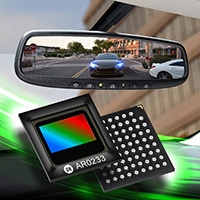Oct 26 2017
On Oct. 25, 2017, ON Semiconductor made an announcement about a CMOS image sensor platform capable of bringing new levels of image quality and performance to automotive applications such as mirror replacement, rear and surround view systems, ADAS and autonomous driving.
 Credit: ON Semiconductor
Credit: ON Semiconductor
ON Semiconductor is the market leader in automotive imaging and focuses on driving energy efficient innovations. The Hayabusa™ platform is available with an innovative 3.0-micron backside illuminated pixel design capable of delivering a charge capacity of 100,000 electrons, the highest ever in the industry, with other main automotive features such as plus real-time functional safety, automotive grade qualification and simultaneous on-chip high dynamic range (HDR) with LED flicker mitigation (LFM).
“The Hayabusa family enables automakers to meet the evolving standards for ADAS such as European NCAP 2020, and offer next-generation features such as electronic mirrors and high-resolution surround view systems with anti-flicker technology. The scalable approach of the sensors from ½” to ¼” optical sizes reduces customer development time and effort for multiple car platforms, giving them a time-to-market advantage.” said Ross Jatou, VP and GM of the Automotive Solutions Division at ON Semiconductor.
ON Semiconductor has been shipping image sensors with this pixel architecture in high-end digital cameras for cinematography and television. We are now putting this proven architecture into new sensors developed from the ground up for automotive standards.
Ross Jatou, VP and GM of the Automotive Solutions Division
The high charge capacity of this pixel design allows every device in the Hayabusa family to deliver Super-Exposure capability, which results in 120-decibel (dB) HDR images along with LFM for superior image fidelity in the a number of challenging scenes without sacrificing low-light sensitivity. The simultaneous LFM and HDR capability is particularly important in improving safety as it guarantees that all objects and possible hazards can be identified in both very bright and very dark areas of the scene. With the extensive use of LEDs for rear and front lighting as well as traffic signs, the LFM capability of the platform ensures that pulsed light sources do not appear to flicker, which can result in driver distraction or, the misinterpretation of a scene by machine vision algorithms in the case of front facing ADAS.
The Hayabusa product family is also available with real-time, ISO26262-compliant functional safety capabilities in order to alert the system processor if the sensor has any potential errors or issues. These features allow system designs rated up to ASIL-C. The real-time ability enables errors to be identified instantly instead of waiting for the whole image to be transferred to the processor and then waiting for image analysis. With this faster response time, the system processor will be able to take immediate action to remedy the issue, which is vital when taking into account that a vehicle moving on a freeway effortlessly covers 100 feet in less than one second.
The 2.6 megapixel (MP) AR0233 CMOS image sensor, the first product in this family, is capable of running at 60 fps while simultaneously distributing LED flicker mitigation and ultra-high dynamic range along with all the Hayabusa platform features. Samples are currently available for early access customers. For more information, ON Semiconductor sales representatives can be contacted.